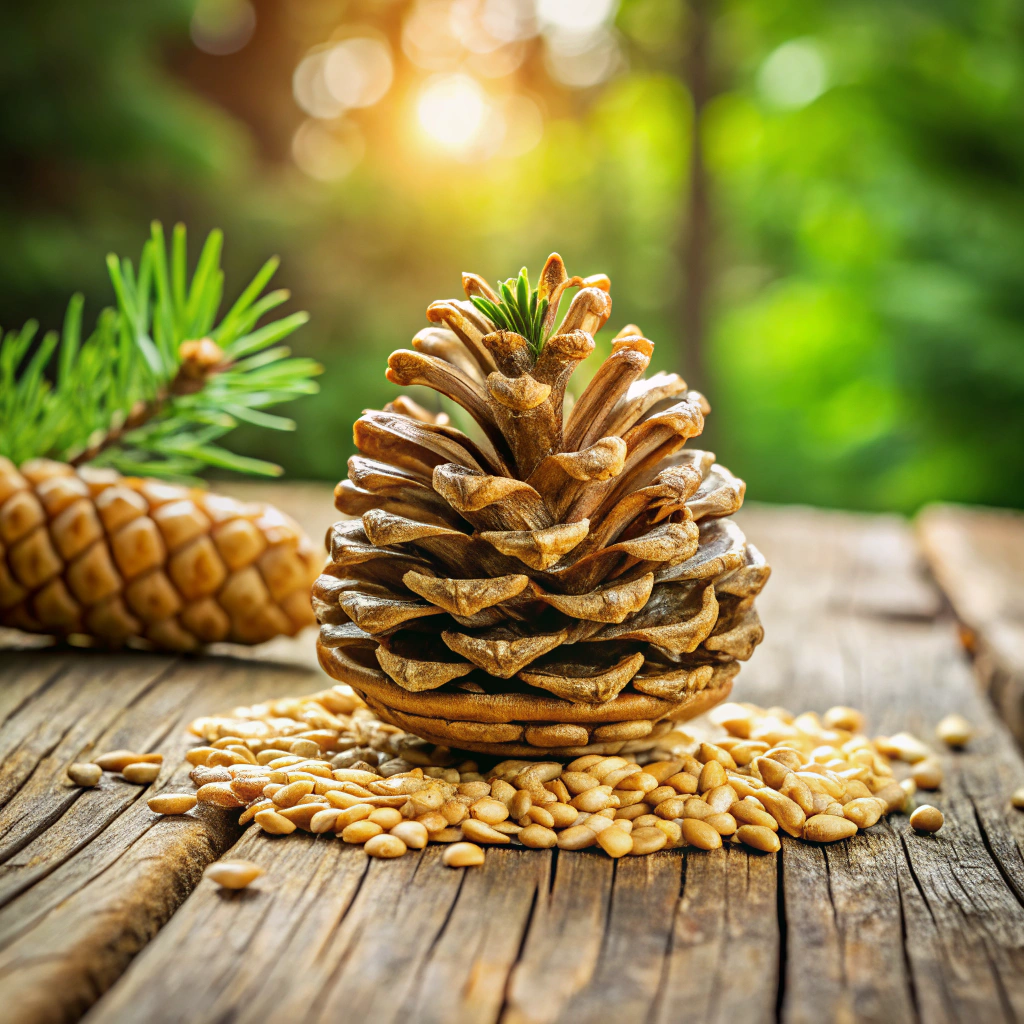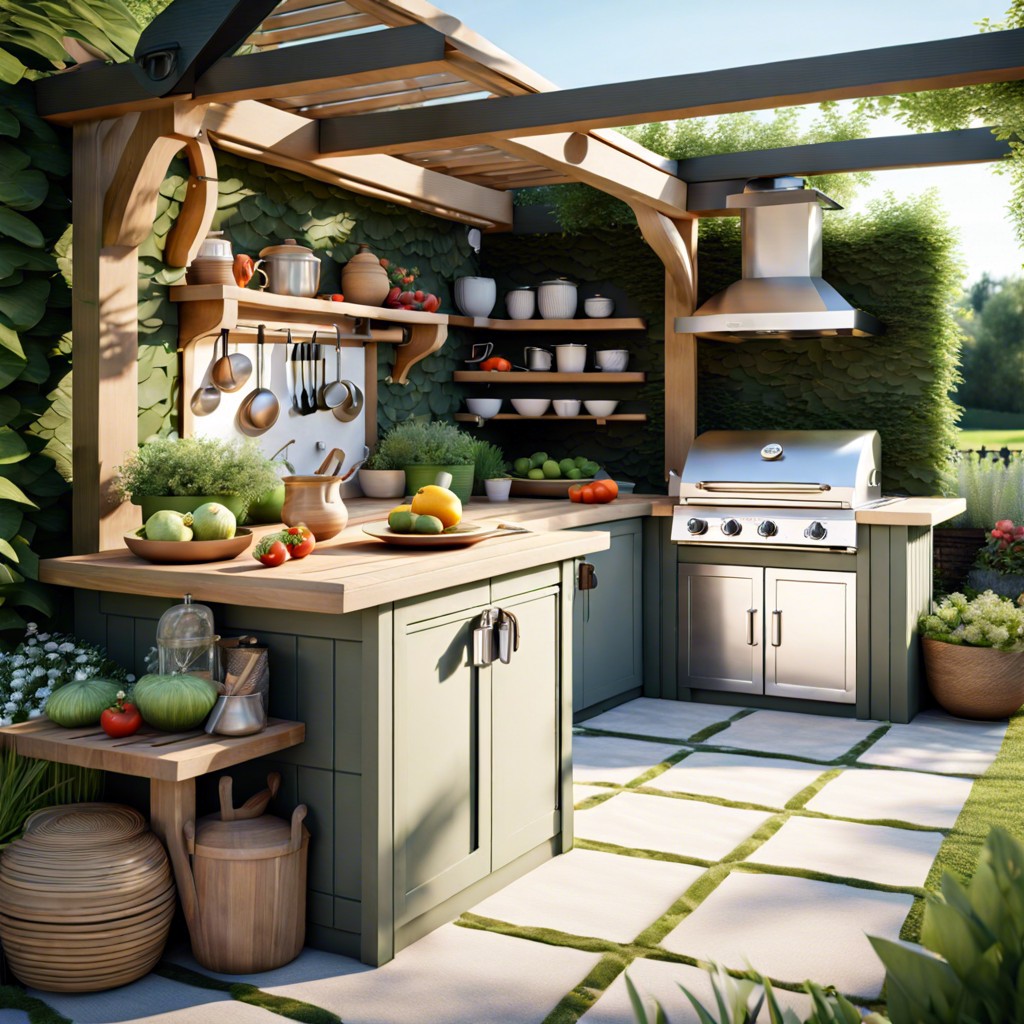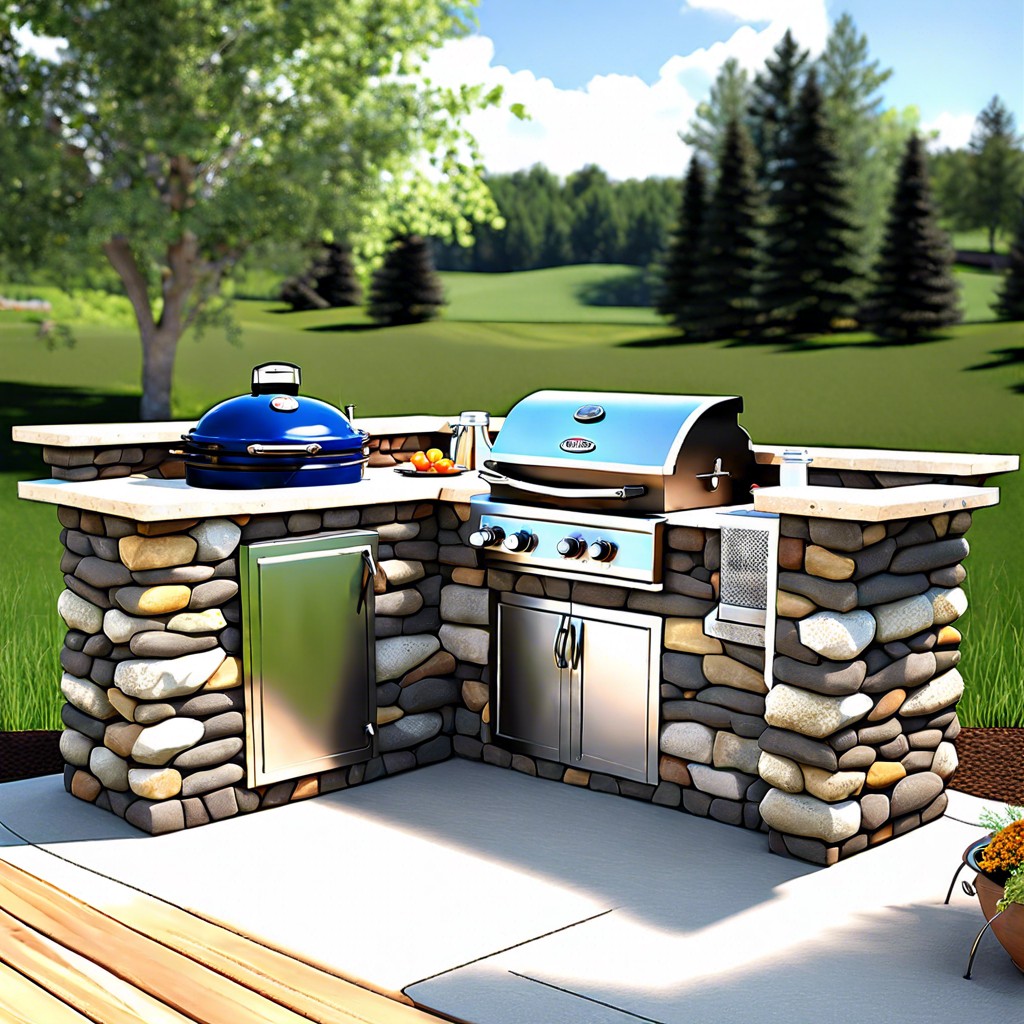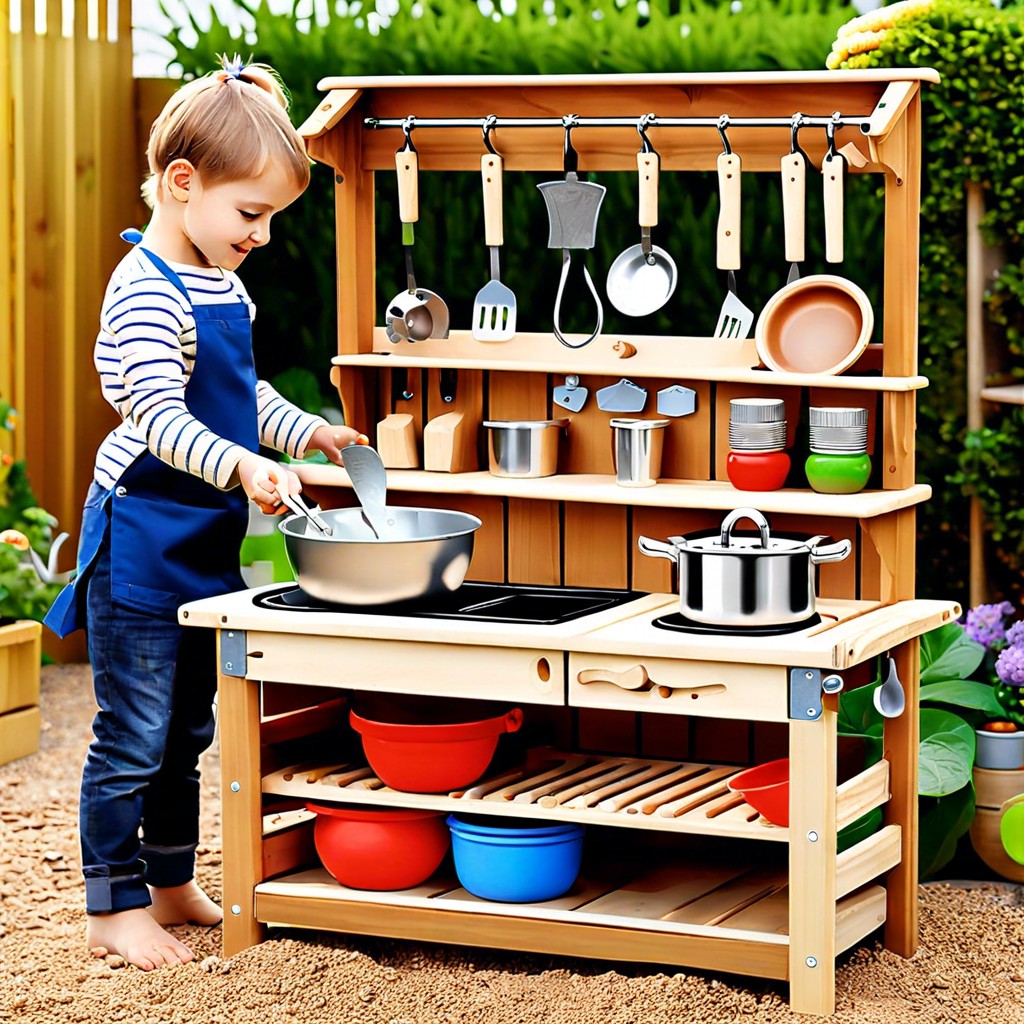Last updated on
Choosing the perfect trees for your pool area is paramount because the right selection can create an exotic paradise, preserve privacy, and minimise pool maintenance.
Key takeaways:
- Choose trees with non-invasive roots to avoid pool damage.
- Opt for trees that don’t drop excessive leaves, seeds, or fruits.
- Ensure trees fit the space without overcrowding or excessive trimming.
- Select trees with low water needs to avoid chlorinated water damage.
- Pick trees that thrive in your region and withstand pool conditions.
What's Inside
What to Consider

Selecting the right trees for your pool area enhances aesthetics and functionality. Consider the following factors:
- Root system: Opt for trees with non-invasive roots to avoid damage to your pool structure and paving.
- Debris: Choose trees that don’t drop excessive leaves, seeds, or fruits, which can increase pool maintenance.
- Size and growth rate: Ensure the tree will fit the space at maturity without overcrowding the area or requiring excessive trimming.
- Water requirements: Trees with low water needs are preferable, as frequent splashes of chlorinated water may harm those with higher sensitivities.
- Climate and hardiness: Pick species that thrive in your region and can withstand the temperature fluctuations and conditions present in a pool area.
Understanding these points will guide you in selecting the ideal trees that coexist harmoniously with your pool, ensuring a serene and manageable backyard oasis.
Things to Consider Before Placing Trees Around Pools
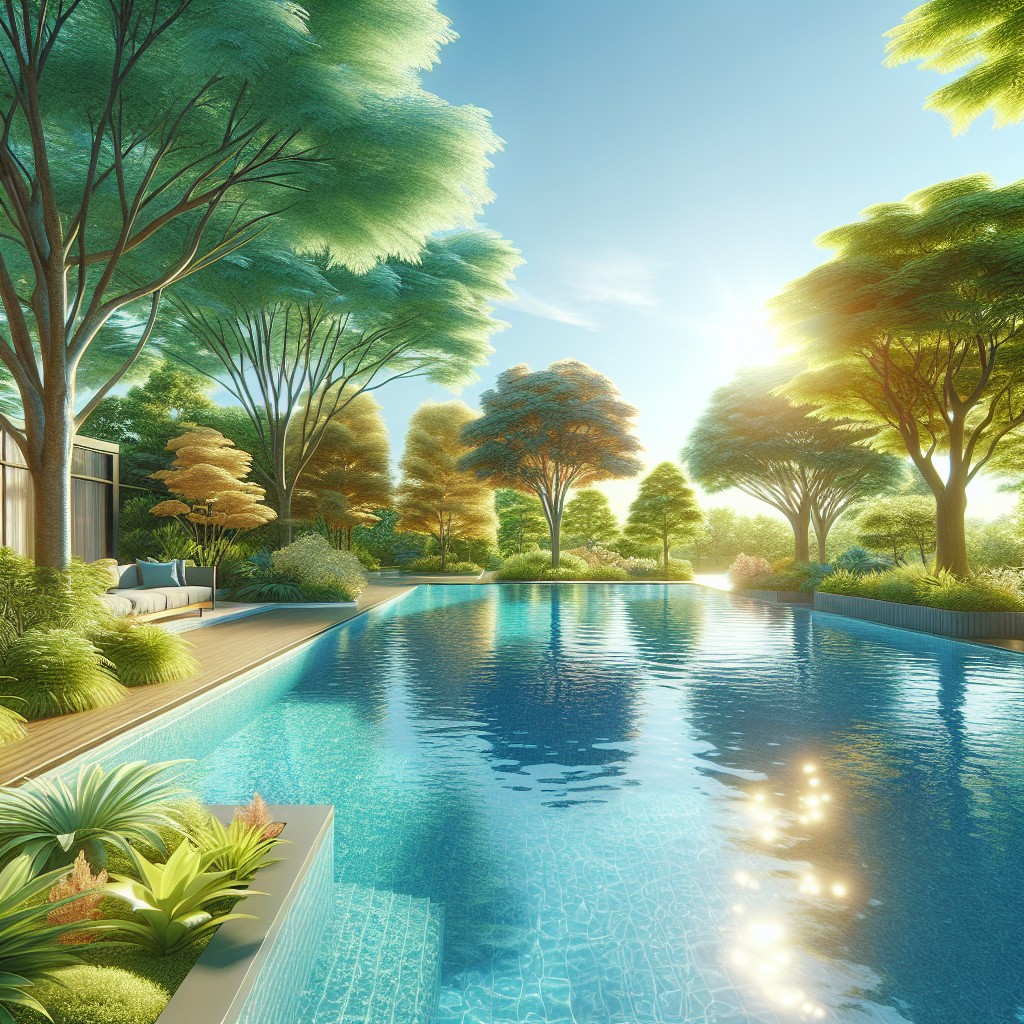
Selecting the right species is critical, but other nuances also play a significant role in your tree-placement strategy. First, assess root growth patterns to prevent future damage to the pool structure and surrounding hardscapes. Consider trees with non-invasive roots that are well-suited for close proximity to pools.
Next, evaluate foliage and debris management. Choose varieties that don’t drop excessive leaves, flowers, or fruit, which could increase pool maintenance. Evergreens might be a preferable option as they minimize seasonal shedding.
You should also think about the tree’s mature size and space requirements to ensure they complement rather than crowd the area. This foresight helps maintain the balance between shaded areas and sun exposure around the pool.
Lastly, take the pool’s aesthetic into account. Trees should blend harmoniously with the pool’s design and the overall landscape theme. Choose those with appealing shapes and colors that enhance the pool environment, promoting a tranquil and inviting outdoor space.
The Best Trees to Plant Around a Pool
When choosing the ideal trees for your pool area, it’s important to prioritize species that are low-maintenance and can coexist harmoniously with the water and hardscape elements. Opt for trees with less invasive root systems to prevent any damage to the pool structure.
Palm trees are a quintessential choice, offering tropical vibes and requiring minimal upkeep. They shed very little and don’t have extensive root systems, making them perfect poolside companions. Varieties like the Pygmy Date Palm or Dwarf Palmetto can be especially suitable for smaller spaces.
Citrus trees bring a medley of benefits, including fragrant blossoms and vibrant fruit, while typically being non-invasive. Their moderate size makes them easy to manage, and as an added bonus, you’ll have fresh citrus at your fingertips.
Japanese Maple trees are prized for their graceful growth habit and stunning foliage, which comes in a variety of colors. They provide an elegant, soft structure that doesn’t overpower the pool setting and are relatively clean, meaning fewer leaves to skim out of the water.
Remember, these trees aren’t just about aesthetics; they also act as natural privacy screens and can help to filter the sunlight on particularly bright days, creating a cozy, shaded area for relaxation by the pool. Choose wisely, and your poolside paradise will be evergreen—or ablaze with autumnal color, depending on your selection.
The Worst Trees to Plant Near a Pool
Selecting unsuitable trees for pool areas can lead to increased maintenance, potential damage, and safety hazards. Avoid species that are notorious for their invasive roots, which can crack pool foundations and underground plumbing. Such trees include willows, poplars, and elms — all of which seek water sources aggressively enough to disrupt your pool’s structure.
Also steer clear of trees that are known to drop a significant amount of debris. Leaves, needles, fruits, or flowers can clutter pool filters and surfaces, necessitating constant cleaning. Typical offenders are pines, leaving needles and cones; deciduous trees like oaks and maples, which shed large quantities of leaves; and fruit-bearing trees, which add the challenge of rotting fruit.
Lastly, consider the potential of allergic reactions from certain trees. For example, cottonwoods produce large amounts of airborne seeds that can irritate allergies, and some people are sensitive to the oils in evergreens like cypress trees.
By avoiding these types of trees, you can prevent future pool-side woes and enjoy a more serene and manageable backyard oasis.
Landscaping Considerations
Effective landscaping around your pool area hinges on thoughtful consideration of several factors:
- Growth Pattern: Opt for trees with predictable growth habits to avoid future interference with pool structures or underground plumbing.
- Foliage and Debris: Select species with minimal leaf drop to reduce pool maintenance and avoid clogging filters.
- Root System: Choose trees with non-aggressive roots to prevent damage to the pool walls and surrounding hardscapes.
- Shade and Sunlight: Balance the need for shade with the desire for warm, sunny poolside areas by considering the size and shape of the tree canopy.
- Water and Chemical Tolerance: Ensure that chosen trees can withstand the splash-out from chlorinated water, which could harm sensitive plants.
- Poolside Aesthetics: Consider the visual impact, looking for trees that complement your pool’s style and create an inviting atmosphere.
By focusing on these landscaping principles, you’ll promote both the beauty and functionality of your poolside oasis.
Excellent Tree Choices
Selecting the ideal trees for your pool area is crucial for maintaining a clean and serene ambiance. Palm trees, for instance, evoke a tropical feel and are known for their minimal leaf drop. Their roots are generally non-invasive, making them pool-friendly. Varieties like the Lady Palm (Rhapis excelsa) and the Pygmy Date Palm (Phoenix roebelenii) are excellent choices.
Citrus trees add a burst of color and fragrance, providing an aromatic environment. They also have the benefit of being evergreen, reducing leaf litter. Types like the Dwarf Meyer Lemon (Citrus × meyeri) can be perfect when space is limited.
Japanese Maples are a visual delight with their elegant, sculptural forms and stunning fall colors. They’re compact and non-invasive, ideal for creating a soft canopy without overwhelming the area. Keep in mind they prefer some shade in hotter climates to prevent leaf scorch.
When selecting trees, prioritizing low-maintenance, non-invasive species with a track record of thriving in poolside environments will result in a picturesque and practical pool setting.
Palm (Various Genera)
Palm trees embody tropical elegance, making them a popular choice around pools. Their towering, slender trunks don’t occupy much space—ideal for narrow poolside strips.
Palms shed very little leaf material—fewer worries about cleaning debris out of the water. Plus, their root systems are generally non-invasive, minimizing potential damage to the pool structure.
Select species like the Majesty Palm for its lush, arching fronds, or the Pygmy Date Palm for smaller spaces due to its slow growth.
For a classic look, consider the Canary Island Date Palm with its impressive stature and crown. Always check the hardiness zone when choosing a palm, as not all varieties withstand cold climates.
Regular maintenance, including trimming dead leaves, ensures healthy growth and a tidy appearance.
Citrus (Citrus Spp.)
Citrus trees add a zesty charm to poolside landscapes, offering both visual appeal and practical benefits. With their glossy evergreen foliage and bright fruit, varieties such as lemon, lime, and orange infuse a Mediterranean or tropical ambiance.
These trees are relatively clean, dropping minimal debris into the pool. They often have non-invasive root systems, making them safer choices for nearby plumbing and hardscaping. Moreover, as a bonus, they provide fresh fruit for poolside snacks or beverages.
However, it’s crucial to choose dwarf or semi-dwarf varieties to ensure they remain a manageable size for the space. Regular pruning also helps maintain their shape and prevents any overhanging branches, which could become problematic over time.
It’s worth noting that while they are aesthetically pleasing and serve a dual function, they do require adequate sunlight and may need protection from frost in cooler climates.
Japanese Maple (Acer Palmatum)
Acer palmatum, with its elegant foliage and stunning fall colors, serves as both an aesthetic and practical choice for poolside planting. These trees keep their leaves close, limiting the number of strays that find their way into your pool. Their non-invasive root systems mean you won’t be battling with underground growth that could damage your pool’s structure in the years to come.
Additionally, Japanese maples are available in a variety of sizes and forms, allowing you to select a cultivar that complements your space perfectly. They do require some protection from the hottest sun in warmer climates, making them an ideal choice for pool areas with partial shade. Plus, Acer palmatum species, although not evergreen, maintain their structure during winter months, providing year-round interest.
Landscaping Control Tips for Pool Owners
Selecting the right trees is just the first step. Proper landscaping control maximizes the benefits of your poolside greeneries while minimizing maintenance hassles.
Prune Regularly: Pruning prevents overgrowth, ensuring that trees remain a manageable size and don’t encroach on the pool area.
Root Barriers: Installing root barriers can keep aggressive roots at bay, protecting your pool’s structure from potential damage.
Leaf Nets and Pool Covers: Utilize these accessories during high leaf-drop seasons to keep your pool clean and reduce cleaning efforts.
Strategic Planting: Space trees far enough from the pool to minimize leaf debris and shade that could cool the water excessively or promote algae growth.
Soil Considerations: Choose the right soil amendments to improve drainage and prevent waterlogged roots that can be problematic near pools.
Irrigation Systems: Opt for drip irrigation to deliver water directly to the tree roots, avoiding excess water around the pool area which can cause slippery conditions.
By adhering to these tips, you can enjoy a beautiful, practical pool landscape that requires minimal upkeeping.
FAQ
What is the best arborvitae for a pool area?
The best arborvitae for a pool area is either the Emerald Green Arborvitae or the Nelly R Stevens Holly as they create a solid privacy screen and emulate a tropical getaway ambiance.
What are the best low maintenance plants around the pool?
Agave, yucca, and echeveria are top choices for low maintenance poolside plants due to their resilience, minimal mess production, and ability to thrive under sunny conditions.
Which are the top palm trees suitable for pool landscape?
The top palm trees suitable for pool landscape include the Bismarck Palm, Date Palm, Areca Palm, Canary Island Date Palm, and the Coconut Palm.
How do deciduous trees affect the condition of your pool?
Deciduous trees shed their leaves annually which can dirty your pool, potentially clog filters, and alter the water’s chemical balance.
What factors should be considered when choosing trees for a saltwater pool environment?
When choosing trees for a saltwater pool environment, consider factors such as salt-tolerance, hardiness zone, growth rate, droppings such as leaves/fruits, root invasion, height and width at maturity, and aesthetic appeal.
